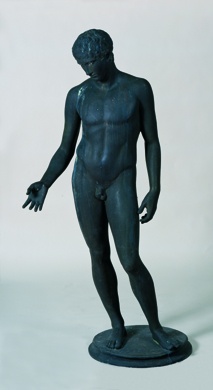Die Statue des sog. Idolino stellt einen nackten Jüngling dar, der in seiner Rechten ursprünglich eine Weinranke trug. Das antike Original des Nachgusses wurde 1530 in einer römischen Villa bei Pesaro gefunden (heute Florenz, Archäologisches Museum). Es handelt sich um eine römische Bronzestatue, die in klassizistisch-eklektischer Manier Werke der griechischen Klassik, insbesondere des Polyklet, rezipiert. Die römische Bronzestatue diente dann als Leuchter, als sog. "Lychnouchos" (= "Lampen-Träger").
Geschenk Dr. Wolfgang von Wangenheim
en

